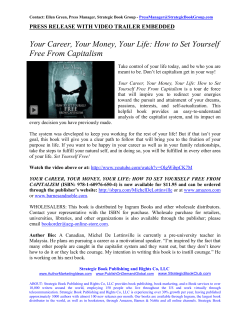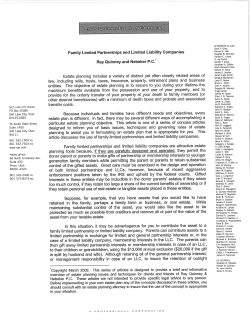
A STRATEGY FOR PERFORMANCE EXCELLENCE
A STRATEGY FOR PERFORMANCE EXCELLENCE 2000, QualityToolBox.com, LLC, all rights reserved Performance Excellence Series Training Module Elements Executive Overview Lecture notes Knowledge Breakthrough Tools Workbook Lecture notes Participant manual 2000, QualityToolBox.com, LLC, all rights reserved Table of Contents Knowledge Breakthrough Session 1.0 Session 2.0 Session 3.0 Session 4.0 Session 5.0 Session 6.0 Session 7.0 Introduction…………………………3 Wastes Elimination…………………7 One-piece flow…………………….26 Single Minute Exchange of Dies…..65 Visual Control and Workplace Organization……………………… 78 Quality the first time, every time… 97 Total Productive Maintenance…...127 2000, QualityToolBox.com, LLC, all rights reserved Continuous Improvement Is the continuous elimination of waste 2000, QualityToolBox.com, LLC, all rights reserved What Does Kaizen Mean? + KAI To modify, to change ZEN Think, make good, make better = KAIZEN Make it easier by studying it, and making the improvement through elimination of waste. 2000, QualityToolBox.com, LLC, all rights reserved CPI (Continual Performance Improvement) • Data Driven Methodology to Magnify Impact of Process Improvement • Apply Control Techniques to Eliminate Erosion of Improvements • Proceduralize/Standardize Improvements for Improved Maintenance of Critical Process Parameters Process Improvement Project Implemented Maintenance of Process Performance Time CPI Project CPI Projects Emphasize Control and Long Term Maintenance Savings Kaizen Time • Use Small Teams to Optimize Process Performance by Implementing Incremental Change • Apply Intellectual Capital of Team Members Intimate with Process Kaizen Projects Emphasize Incremental Improvements 2000, QualityToolBox.com, LLC, all rights reserved Kaizen Savings Savings Why Kaizen CPI Time The Nine types of waste 9 Wastes • • • • • • • • • Overproduction Delays (waiting time) Transportation Process Inventories Motions Defective products Untapped resources Misused resources 2000, QualityToolBox.com, LLC, all rights reserved 1. Overproduction 9 Wastes To produce more than is required * To produce before required * *Required by external and internal customers 2000, QualityToolBox.com, LLC, all rights reserved Elimination of Wastes and Continuous Improvement • The Secret: • Be Systematic • • • • • • • • • Work with a versatile team Measure, evaluate Find the 5 Whys Follow up Standardize, make uniform Simplify Combine Prevent Make waste ugly 2000, QualityToolBox.com, LLC, all rights reserved Think Break Exercise 1: Wastes Identification 1. List at least one example of each of the 9 categories of waste from a process within your organization. 2. Identify at least one possible cause for each of the specific wastes listed. 3. Propose one or more actions to reduce each of these wastes. 4. Identify methods of measurement to determine results of waste reduction efforts. 2000, QualityToolBox.com, LLC, all rights reserved Think Break Exercise 1: Wastes Identification Identify one example of each type of waste below Possible cause Overproduction Delays Transportation Process Inventories Motions Defective products Untapped resources Misused resources 2000, QualityToolBox.com, LLC, all rights reserved Proposed Action Method of measurement We will learn to: • Recognize our lead-times • Identify their components • Reduce them with the help of – the dedicated lines – a one piece flow • Establish dedicated lines – in relation to family of parts – in relation to TAKT time • Attain one piece flow 2000, QualityToolBox.com, LLC, all rights reserved When the delivery lead-time is bigger than the manufacturing lead time: This is life! Delivery lead time Manufacturing lead time If not, it’s torture… Delivery lead time Manufacturing lead time 2000, QualityToolBox.com, LLC, all rights reserved What is the solution? False appearance of a solution Delivery lead time Manufacturing lead time Generate and support stocks Solution… Delivery lead time Manufacturing lead time 2000, QualityToolBox.com, LLC, all rights reserved How to reduce the manufacturing lead time? Delivery lead time Manufacturing lead time Identify and eliminate all wastes in our manufacturing processes Example: manufacture a Total operations: 6 hours Mfg. lead-time: 40 days = Difference: 320 hours 314 hours ? 2000, QualityToolBox.com, LLC, all rights reserved What are processes made of ? Delivery lead time Manufacturing lead time Example: manufacture a Total operations: Mfg. lead-time: 40 days = Difference: Storage, Transport, 98% Waiting time 2000, QualityToolBox.com, LLC, all rights reserved 6 hours 320 hours 314 hours Visual Control & the Workstation To Sort To Straighten Eliminate what’s not absolutely necessary Ensure space for each thing, and a thing for each space. No more searching. The 5S To Sustain To Sanitize Improvement of the workstation. Be organized to reduce clutter. 2000, QualityToolBox.com, LLC, all rights reserved Maintain continuous effort. This is a way of life. To Sweep Maintain a clean and orderly space to make problems easily identifiable. Eliminate rejects and scrap.. Visual Control & the Workstation Ergonomics •Adapt the workstation to the employee - more security - more comfort •Reduce waste - excessive fatigue - useless efforts and movement - less physical constraints 2000, QualityToolBox.com, LLC, all rights reserved Kaizen for the Workplace Training and Sourcebook for Kaizen Worksheets How to Use This Manual The continuous improvement tools that are presented in Sections 1-9 of this manual are shown in order of use. These forms MUST be completed in the order presented in this manual. Each section contains a brief description of the tool, its purpose, when to use it, who should use it, how to use it, and the expected results. Remember to focus on the elimination of waste. Strive to maximize yields and obtain cost reductions from existing machinery and equipment before “buying solutions”. Improve current systems and techniques before automation. Automating a system or practices without first having an understanding of the process will not solve underlying process problems. Perhaps the most important point to remember is that we must understand a process before we make any attempt in changing it. “No Tampering” is the first rule of continuous improvement. We can not tamper with a process without understanding it. By using these tools, we will all share a common and systematic approach for questioning, analyzing, proposing solutions, experimenting, and finally, implementing proven changes. “The problems that exist in the world today cannot be solved by the same level of thinking that created them.” Identify waste Leadership Improvement Kaizen Template Measurement Table of Contents Section 1 Section 2 Section 3 Section 4 Standard Work Sheet (SWS): Used to create a visual picture of a work area. Shows crew size and location; office layout, distances within the work area, work in process, quality checks, and safety precautions……………………………………………………………….. . Time Observation Form (TOF): Used to identify each task performed in a process or section of a process. Further used to identify actual times for each task in order to determine the overall process cycle time……………………………………………………….. Standard Work Combination Sheet (SWCS): Used to graphically show each task time within a process in terms of it’s relation to Walking, Manual, Auto and Idle time. It further shows tasks which are performed in series and/or parallel [for further analysis]………… Workload Balancing Sheet (WBS): Used to graphically show the relationship between process cycle time(s) and TAKT time in order to examine the line balance and resolve any rebalance [waste] opportunities which may exist…………………………………………… 4 7 11 14 Kaizen Action Sheet: Used to record problems/opportunities which are identified by the process. The Action Sheet also records the corrective actions, expected results, a drawing of the before and after process, and finally measurements which will be used to assess results…………………………………………………………….. 17 Kaizen To Do List: Used to provide a summarized list of all KAIZEN Action Sheets, the primary person responsible to follow-up on each action, a due date for action item completion, and finally a graphic display of the percent completion for each action item………………………………………………………………………… 20 Kaizen Target Sheet: A visual format for comparing continuous improvement efforts to a desired target and known starting value………………………………………………………………………. 23 Section 8 Kaizen Target Sheet Definitions…………………………………….. 26 Section 9 Kaizen Improvement Results: Used to document the before and after results of improvement activities associated with key performance metrics. …………………………………………………. 28 Section 5 Section 6 Section 7 TIME OBSERVATION WORKSHEET Sheet 2 Page Date: Task/Process Being Observed Step No. Observer(s) of Day/Time Of Observation Observation Number Task Component 1 Time For One Cycle 2 3 4 5 6 7 8 9 10 11 12 Assigned Component time Total Time REMARKS Running Time (cumulative) Time for each Component Time Observation Form Purpose Used to identify each task performed in a process or section of a process. Further used to identify actual times for each task in order to determine the overall process cycle time. When To Use The Time Observation Form (TOF) should be used after the Standard Work Sheet and Spaghetti Diagram have been completed. Who Should Use It The Time Observation Form can be used by anyone involved in continuous process improvement. Expected Benefits The Time Observation Form will provide information about work sequence, work content, and operation times. The TOF not only provides actual times, but also provides best demonstrated performance, on the specific process being analyzed. How to use it 1. Complete Sections A. B, and C. with the necessary information. 2. Fill in the Task Component blanks with the steps of the process. List the components in as specific terms as possible, i.e., 1. Walking to get work piece. 2. Removing work piece from basket. 3. Walking to machine. 4. Loading piece into machine. And so on. 3. Begin timing the tasks. As each task is completed, stop the watch and record the cumulative time on the form. Continue recording task times in this manner until the end of the process cycle 4. At the completion of 12 full cycles, calculate and enter the “Assigned Component Time” for each “Task Component”. Then sum up the “Assigned Component Time” for each “Task Component” and enter this into the “Time For One Cycle” field. Be sure to include the time spent on closing out work orders, or moving parts to next job. 5. During the manufacturing process, be aware of the steps taken to perform the job, i.e. If a particular task component varies from 4 second for observation #1 and 47 seconds for observation #2, provide comments about the observed variance in the remarks column. Remember, in our quest to remove waste from the process, we want to question every task component of the process. 6. Once the actual cycle times are known, compare them to TAKT time. TAKT Time for measurable, repetitive task processes is calculated as follows: A. Calculate the total time available per shift, day, etc. excluding breaks and lunches. Let’s say that we have a full 8 hours available. 8 hours would equal 480 minutes or 28,800 seconds. B. Determine the required product quantity. [How many units have been sold] For this example, let’s use 395 units for the required production for this operation. C. Next, divide the total time available by the required production to arrive at the TAKT Time. 28,800 / 395 = 73 seconds per unit. D. Compare this TAKT time to the average cycle time of the observation. 1. 2. If TAKT Time is greater than average cycle time, then we can conclude that the required production can be met within the total time available. However, we need to examine adding work from another process to minimize idle time. If TAKT Time is less than average cycle time, then we can conclude that the required production cannot be met within the total time available. We must eliminate work through Kaizen or transfer work to another worker.
© Copyright 2025




![Congress story_Chile[1]](http://cdn1.abcdocz.com/store/data/000657373_1-1bcd9d0c73a80d45562dd4951d9e82fb-250x500.png)












